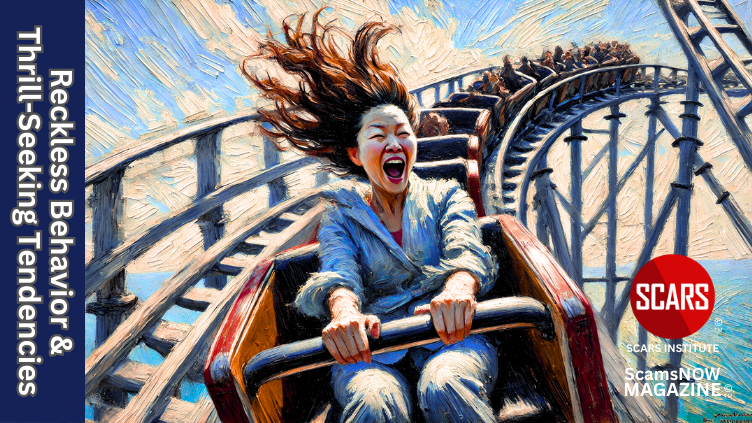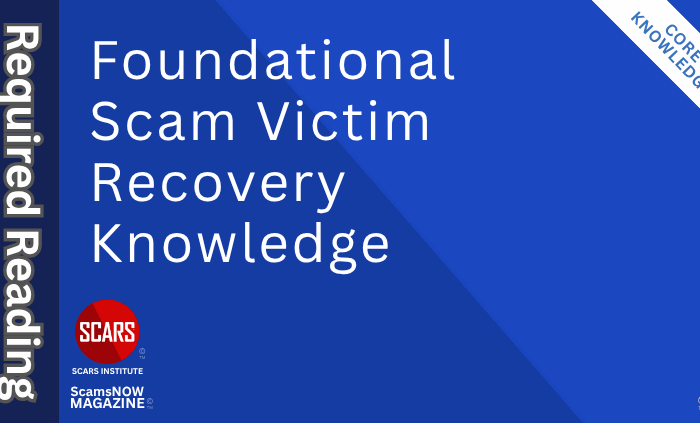Reckless Behavior and Thrill-Seeking Personality Types and Susceptibility to Scams
Reckless Behavior and Thrill-Seeking Tendencies: How They Are Affected by Trauma, and How They Lead to Increased Scam Victimization
Primary Category: Psychology of Scams
Authors:
• Vianey Gonzalez B.Sc(Psych) – Licensed Psychologist, Specialty in Crime Victim Trauma Therapy, Neuropsychologist, Certified Deception Professional, Psychology Advisory Panel & Director of the Society of Citizens Against Relationship Scams Inc.
• Tim McGuinness, Ph.D., DFin, MCPO, MAnth – Anthropologist, Scientist, Polymath, Director of the Society of Citizens Against Relationship Scams Inc.
About This Article
Reckless behavior and thrill-seeking tendencies often go unnoticed because they do not always look extreme. They can appear as impulsive decisions, risky relationships, emotional overreactions, or the urge to act quickly without thinking. These behaviors become especially significant when shaped by trauma, which alters how the brain perceives danger, reward, and emotional regulation. For trauma survivors, recklessness can serve as a way to escape emotional pain, override numbness, or feel temporarily alive. While these patterns may seem like personality flaws, they often reflect deeper coping mechanisms developed under stress. Unfortunately, these traits also increase vulnerability to scams.
Scammers exploit urgency, excitement, and emotional reactivity, targeting people who are more likely to act without verification or pause. Sensation-seekers, impulsive thinkers, and people with low conscientiousness are statistically more likely to fall for high-reward or emotionally charged scams. Recognizing these internal patterns is the first step toward prevention. By building in delay systems, setting boundaries, using technology wisely, and redirecting the need for intensity into safer outlets, individuals can protect themselves without suppressing who they are. Scam awareness starts not only with identifying external tactics but also with understanding the internal traits that make those tactics effective. Self-awareness is your strongest protection.
Note: This article is intended for informational purposes and does not replace professional medical advice. If you are experiencing distress, please consult a qualified mental health professional.

Reckless Behavior and Thrill-Seeking Tendencies: How They Are Affected by Trauma, and How They Lead to Increased Scam Victimization
You are probably not going to like this article about Reckless Behavior and Thrill-Seeking Tendencies. It’s because it talks about a subject that you are probably not aware of, but you may be engaging in without knowing.
Most people think of reckless behavior and thrill-seeking as extreme actions, like skydiving without a parachute or driving at dangerous speeds. While those examples are real, they only represent the edges of a much broader pattern. What many don’t realize is how often these tendencies show up in everyday life. Recklessness can look like impulsive spending, ignoring red flags in a relationship, chasing high-risk investments, or saying yes to something without thinking it through. Thrill-seeking might appear as constant restlessness, emotional risk-taking, or a need for intensity in situations where calm would serve better. Even the types of movies you choose, gritty crime thrillers, action-heavy blockbusters, or high-stakes survival stories, can reflect an unconscious attraction to stimulation, chaos, or danger. These patterns often go unnoticed because they don’t always seem dangerous on the surface. Yet for many people, especially those with trauma histories, this behavior quietly influences daily decisions, relationships, and emotional regulation without ever being named or understood.
This article explores the connection between psychological trauma, impulsivity, and high-risk behavior. It explains how trauma changes the brain, why some people are more drawn to danger after suffering harm, and how these patterns can be recognized and redirected. Understanding the roots of recklessness can help you or someone you support build safer habits, develop healthier coping strategies, and reclaim control over choices that once felt automatic.
Introduction to Reckless Behavior and Thrill-Seeking Tendencies
Reckless behavior and thrill-seeking tendencies are often misunderstood. Many people view them as signs of immaturity, poor judgment, or carelessness. In reality, these behaviors can serve as complex responses to deep psychological patterns, especially those shaped by trauma. When someone experiences intense emotional pain, their brain may begin to rewire how they process risk, danger, and reward. As a result, actions that appear impulsive or dangerous from the outside may feel normal, necessary, or even calming to the person living through them.
For trauma survivors, recklessness is not always about chasing excitement. Sometimes it reflects an attempt to escape emotional numbness, override intrusive memories, or regain a sense of control through risk. In other cases, thrill-seeking becomes a substitute for connection, meaning, or stimulation in a life that feels disconnected and hollow. Whether the behavior shows up as financial risk-taking, unsafe relationships, substance use, or constant movement, it deserves careful attention, not judgment.
What? Dub-Skelper
A Dub-Skelper is a Scottish slang term, mostly used in historical or rural contexts, particularly in Lowland Scots dialect. The word combines two parts:
-
“Dub” means a muddy puddle or patch of wet ground.
-
“Skelper” comes from “skelp,” meaning to strike, slap, or dash through something with force.
So, a Dub-Skelper is someone who runs or splashes noisily through muddy puddles, usually as a child. It often carries a lighthearted or mildly teasing tone, describing someone who plays roughly, messily, or carelessly outdoors, especially in wet or muddy conditions.
In broader use, it can refer to someone who is a bit rough, unrefined, or carefree in their behavior. It’s not usually an insult,it’s more often used with affection or humor, especially when talking about energetic children or country folk with earthy habits.
Example:
“He came in covered in muck, the wee dub-skelper!”
Translation: He came inside covered in mud, that little rascal who’s been running through puddles!
Specific Personality Type
Psychology identifies certain personality traits and types commonly associated with reckless or risk-taking behavior. While not every reckless person fits neatly into one category, several frameworks describe tendencies that help explain this behavior.
High Sensation-Seeking
People high in sensation-seeking crave novel, intense, and risky experiences. This trait is linked to:
-
-
-
Impulsivity
-
Low tolerance for boredom
-
Desire for stimulation
-
Risk-taking in social, physical, financial, or legal contexts
-
-
This personality profile is often found in people who engage in extreme sports, impulsive travel, gambling, or unsafe driving.
Low Conscientiousness (Big Five Model)
The Big Five personality traits include conscientiousness, which reflects how organized, responsible, and cautious someone is. People low in conscientiousness tend to:
-
-
-
Ignore rules and consequences
-
Act on impulse
-
Avoid planning or structure
-
Engage in careless or risky behavior
-
-
Low conscientiousness, combined with high extraversion, often leads to reckless patterns.
Impulsive Personality (High Urgency, Low Deliberation)
In personality research, impulsivity is a multi-faceted trait. Reckless individuals often score high in:
-
-
-
Negative urgency (acting rashly when upset)
-
Positive urgency (acting rashly when excited)
-
Lack of premeditation (not thinking before acting)
-
Lack of perseverance (difficulty sustaining focus)
-
-
These traits often appear in people who take risks without weighing the consequences.
Cluster B Personality Types (DSM-5)
Some reckless behaviors may align with traits in Cluster B personality disorders, such as:
-
-
-
Borderline Personality Disorder: impulsive, emotionally intense, may take risks when distressed
-
Antisocial Personality Disorder: disregard for rules, social norms, or consequences
-
Histrionic Personality Disorder: may take risks to gain attention
-
Narcissistic Personality Disorder: overconfidence may lead to reckless overestimation of one’s control
-
-
Note: These are clinical diagnoses, not labels to apply casually.
Type T Personality (“Thrill-Seeking Type”)
Coined by psychologist Frank Farley, Type T (for “Thrill”) personalities are drawn to stimulation and risk. They tend to:
-
-
-
Seek excitement
-
Break norms
-
Challenge danger
-
Avoid routine
-
-
They are often overrepresented in creative professions, entrepreneurship, and criminal activity.
Recklessness is not just bad decision-making; it often reflects deeper personality traits like impulsivity, sensation-seeking, low conscientiousness, or emotional reactivity. Understanding these patterns helps explain why some people repeatedly take risks despite knowing the dangers. It also shows that reckless behavior may stem from internal temperament, not just poor judgment.
Percentage of the American Population Characterized as One of Those
While it’s difficult to give an exact percentage for how many Americans meet the criteria for “reckless personality types,” psychology research does offer some relevant estimates based on population-level studies.
Here’s a breakdown by category, using the most reliable available data:
High Sensation-Seeking
Estimates suggest that around 10–20% of the population score high in sensation-seeking traits. These individuals are more likely to engage in risk-taking, novelty-seeking, or thrill-seeking behaviors.
-
-
-
Research by Marvin Zuckerman, who developed the Sensation Seeking Scale (SSS), consistently found this trait in about 15% of adults at elevated levels.
-
Rates tend to be higher in young males, especially those between ages 18 and 30.
-
-
Low Conscientiousness (Big Five Model)
Conscientiousness scores are normally distributed, but about 15–20% of people score significantly low.
-
-
-
Low conscientiousness correlates with more reckless, disorganized, or impulsive behavior.
-
It often overlaps with poor impulse control and general rule-breaking tendencies.
-
-
High Impulsivity
About 10–15% of adults score high on impulsivity scales, depending on the subtype:
-
-
-
Lack of premeditation: about 10% score very low in thinking ahead.
-
Urgency traits (emotional impulsivity): about 8–12% display elevated levels.
-
These numbers can increase in high-stress populations or younger cohorts.
-
-
Cluster B Personality Disorders
These are clinical diagnoses, and while rare compared to general traits, they still affect a measurable portion of the population.
-
-
-
Borderline Personality Disorder: ~1.4–1.6%
-
Antisocial Personality Disorder: ~0.6–1% (higher in incarcerated populations)
-
Narcissistic Personality Disorder: ~0.5–1% (some studies say up to 6%, but this includes subclinical traits)
-
Histrionic Personality Disorder: ~1–2%
-
-
In total, Cluster B personality disorders affect about 4–6% of the U.S. population when combined.
Type T Personality (Thrill-Seeking Type)
This is not a clinical diagnosis, but surveys show that about 10–15% of the population fits the Type T pattern, particularly among entrepreneurs, performers, soldiers, and extreme sports enthusiasts.
Overall Estimate
Taking overlap into account (since one person may fall into more than one category), a reasonable estimate is that:
Roughly 20–25% of the U.S. population consistently displays traits associated with reckless or high-risk behavior.
This includes high sensation-seekers, impulsive individuals, people low in conscientiousness, and those with specific personality disorders. Not all are dangerous or antisocial, but many are more likely to ignore risk, push boundaries, or act without considering consequences.
Reckless and Thrill Seekers Involved in Scams
Victims of scams and fraud are not all reckless or thrill-seeking, but when looking specifically at those personality types, research shows they are statistically more vulnerable in certain scam scenarios, especially fast-paced, emotionally charged, or high-reward situations.
Let’s break this down by combining what we know from personality research and victimology studies:
General Scam Victimization in the U.S.
-
Around 20% of U.S. adults report experiencing some form of fraud or scam annually (FTC, BBB).
-
Of that 20%, not all are thrill-seekers or impulsive, but personality traits influence both susceptibility and the type of scam encountered.
How Reckless and Thrill-Seeking Traits Affect Scam Vulnerability
High Sensation-Seekers
Sensation-seeking individuals are more likely to fall for scams that involve:
-
-
-
High rewards (e.g., crypto investment scams, gambling apps, Ponzi schemes)
-
Fast action (e.g., flash sales, time-limited investment pitches)
-
Risk-based appeal (e.g., betting systems, offshore ventures)
-
-
Estimated susceptibility:
Studies suggest sensation-seekers are up to 2.5 times more likely than average to fall for high-risk financial scams. Within this group, about 25–30% may engage with or become victims of a scam at least once, depending on their online behavior and age.
Impulsive Individuals
Impulsivity is consistently associated with poor risk assessment and reactive decision-making. Impulsive people are more likely to:
-
-
-
Click links without vetting sources
-
Respond emotionally to romance scams, emergency scams, or fake threats
-
Fall for phishing emails or urgent payment requests
-
-
Estimated susceptibility:
High impulsivity is a strong predictor of fraud vulnerability. Research from the FINRA Foundation and Stanford University suggests that impulsive individuals are more than twice as likely to fall for scams, especially those involving urgency or emotional manipulation.
Low Conscientiousness
This trait often correlates with disorganization and lack of follow-through, which can lead to:
-
-
-
Weak security habits (e.g., reusing passwords, ignoring security updates)
-
Delayed responses to warning signs
-
Missed red flags in communications or offers
-
-
Estimated susceptibility:
Low-conscientiousness individuals may not actively seek scams, but they often fail to prevent them. Studies estimate that 15–20% of scam victims show significantly low conscientiousness scores.
Type T (Thrill-Seeking) Personalities
These individuals crave stimulation and are drawn to novel opportunities, even if unverified. Scammers often use adventure, freedom, or financial independence as hooks.
Estimated susceptibility:
Although not always impulsive, Type T personalities are prone to investment fraud, high-risk venture scams, and pseudo-entrepreneurial cons. Around 20–25% of Type T individuals report falling for a financial or opportunity-based scam.
Summary of Likelihood
If we look across these groups:
-
-
-
The average American has a 20% chance of encountering or falling for a scam in a given year.
-
Among reckless or thrill-seeking individuals, that number rises to 30–50%, depending on the specific trait and type of scam.
-
These individuals are especially vulnerable to high-reward, high-pressure, or emotionally intense scams.
-
-
Important Note
Recklessness increases scam risk not because the person is unintelligent or naive, but because they:
-
-
-
Ignore red flags
-
Underestimate personal risk
-
Overestimate their control over a situation
-
Act quickly in emotional or urgent moments
-
-
Scammers know this. Many design their tactics to exploit these exact traits.
Psychological Trauma Affects Recklessness and Thrill Seeking
Psychological trauma can increase recklessness and thrill-seeking behavior in several ways, depending on how a person’s brain and coping systems respond to emotional pain, stress, or unresolved fear. Trauma doesn’t affect everyone the same way, but it often disrupts emotional regulation, decision-making, and impulse control, all of which contribute to risk-taking behavior.
Here’s how trauma can drive someone toward recklessness or thrill-seeking:
Trauma Can Disrupt Risk Perception
After trauma, especially in childhood or early adulthood, the brain may become desensitized to risk. If your nervous system spent time in fight-or-flight mode, danger may start to feel normal,or even comfortable.
-
-
-
You may underestimate the consequences.
-
You may become numb to fear or caution.
-
You may seek out intense experiences because they match your internal chaos.
-
-
This skewed sense of risk makes reckless actions feel less dangerous, even when the stakes are high.
Adrenaline Becomes a Coping Mechanism
Trauma survivors often carry internal tension or emotional deadness. High-risk behavior can act as a chemical shortcut to feeling alive.
-
-
-
Thrill-seeking triggers dopamine, adrenaline, and endorphins.
-
These surges temporarily relieve emotional numbness or depressive states.
-
For some, the rush becomes a form of self-medication.
-
-
Over time, this can develop into compulsive behavior,fast driving, impulsive spending, unsafe sex, or risky investments,because the person depends on those spikes to feel normal.
Impulse Control Can Break Down
Unresolved trauma often damages the brain’s prefrontal cortex, which is responsible for:
-
-
-
Judgment
-
Planning
-
Impulse control
-
Weighing consequences
-
-
At the same time, the amygdala (which regulates fear and threat detection) may stay on high alert. This imbalance causes:
-
-
-
Impulsive decisions
-
Overreaction to stress
-
Poor long-term planning
-
-
A trauma survivor may not be able to slow down or “think first,” especially in emotionally intense situations. This creates a pattern where actions happen before reflection, increasing the chance of reckless or regretful outcomes.
Emotional Pain Becomes a Driver for Escape Behavior
Recklessness can also serve as a form of avoidance. Rather than deal with trauma-related emotions (guilt, shame, helplessness), some people seek constant distraction.
-
-
-
High-risk activities keep attention outward, not inward.
-
Thrill-seeking allows a temporary break from grief or flashbacks.
-
Escapism can evolve into addiction to novelty, danger, or adrenaline.
-
-
This form of recklessness is not pleasure-seeking in the usual sense. It’s often pain-avoidant, even when it results in harm.
Self-Destruction Can Mask as Risk-Taking
Some trauma survivors develop an unconscious belief that they deserve punishment or are already damaged beyond repair. This can lead to self-destructive risk-taking, including:
-
-
-
Unsafe behavior with no regard for personal well-being
-
Willingness to trust dangerous people
-
Deliberate sabotage of relationships, finances, or career
-
-
This behavior is not thrill-seeking in a healthy sense,it is recklessness as emotional expression. It says, “I don’t care what happens to me,” or “I want to feel something, even if it’s pain.”
Trauma Can Coexist with Sensation-Seeking Personality Traits
Some people are born high in sensation-seeking, and when trauma enters the picture, it intensifies this drive. You may see:
-
-
-
People who take bigger risks after trauma, not smaller ones
-
Survivors who seek danger because safety now feels foreign
-
Individuals who use thrill-seeking to override trauma symptoms, especially dissociation
-
-
This overlap can lead to a cycle where risk becomes a lifestyle,constant movement, constant newness, no reflection or rest.
Attachment Trauma Can Fuel Reckless Relationships
People with attachment trauma may take emotional or sexual risks in relationships that mirror their early pain.
-
-
-
They may rush into intimacy with strangers.
-
They may tolerate abusive dynamics.
-
They may confuse danger or chaos with passion.
-
-
This creates vulnerability to romance scams, emotional manipulation, and repeated cycles of loss. The risk-seeking here isn’t about fun,it’s about seeking validation, connection, or rescue under dangerous terms.
How to Moderate This Pattern
If you recognize reckless or thrill-seeking behavior in yourself following trauma, it does not mean you are broken or beyond help. It means your brain and body are trying to adapt to extreme stress using the tools available. You can learn new ones.
Practical approaches include:
-
Trauma therapy (e.g., EMDR, somatic experiencing, IFS) to resolve the emotional drivers behind risk-seeking
-
Mindfulness and body-based practices to build awareness and impulse control
-
Safe, structured thrill-seeking like martial arts, mountain biking, or performance arts
-
Support groups that validate your experience without judgment
-
Clear boundaries and planning rituals to reduce impulsive decision-making
Recklessness and thrill-seeking can be symptoms of trauma, not personality flaws. When your brain has been shaped by fear, loss, or violation, danger may feel more familiar than safety. But with support, you can learn to tell the difference between risk that brings growth and risk that brings harm. You do not need to suppress your intensity. You only need to channel it into forms that protect your life instead of placing it in jeopardy.
Avoiding Scams
People with reckless, impulsive, or thrill-seeking tendencies can absolutely reduce their risk of scams and fraud,but they need structured, proactive strategies that work with their personality, not against it. Telling these individuals to “just be careful” or “slow down” isn’t effective unless it’s tied to specific behaviors and habits they can build.
Here’s how they can moderate their risk in realistic and sustainable ways:
Replace Impulsivity With Delay Rules
Impulsive personalities tend to act before thinking. Build in mandatory delay steps:
-
-
-
Use a 24-hour rule: If something feels urgent (investment offer, romantic message, business proposal), wait one full day before responding. In other words, sleep on it.
-
Say out loud: “This could be a scam.” Hearing the words can interrupt impulsive action.
-
Create a “cool-down contact”: Assign one trusted person to run suspicious messages or offers by before you act.
-
-
This adds just enough friction to prevent acting on emotion alone.
Avoid Situations That Trigger Risky Excitement
Thrill-seeking individuals tend to be drawn to high-stimulation environments, so avoid the digital spaces where scammers thrive:
-
-
-
Stay off high-risk platforms like unmoderated forums, crypto chat rooms, or unsolicited investment groups.
-
Avoid DMs from strangers, especially if they flatter you, offer business, or ask to move the chat elsewhere.
-
Ignore cold outreach from unknown phone numbers, emails, or text messages, even if they sound exciting.
-
-
Scammers prey on curiosity and adrenaline. If you know those are your triggers, don’t give them the opportunity.
Set Hard Financial Boundaries
Make rules for money before temptation shows up:
-
-
-
Never send money to someone you’ve never met in person.
-
Never invest in something you found on social media or via private message.
-
Use a separate debit card with a small balance for online purchases, side projects, or test investments.
-
-
Write these rules down and commit to them. Impulsive individuals do better when limits are set before a choice arises.
Use Technology as a Safety Net
Let tools and systems compensate for risky tendencies:
-
-
-
Password managers prevent you from reusing passwords or falling for fake login screens.
-
Spam blockers and antivirus software reduce exposure to scam messages.
-
Two-factor authentication adds a required second layer that slows down scammers and gives you time to think.
-
-
If your risk comes from fast decisions, these tools buy you the seconds or minutes you need to reconsider.
Recognize Scam Language Patterns
Thrill-seekers and impulsive types often fall for scams that use emotional or urgent language. Train yourself to pause when you see these phrases:
-
-
-
“Act now before it’s too late”
-
“You’ve been specially selected”
-
“This opportunity won’t last”
-
“I’m stuck and need your help”
-
“Don’t tell anyone else yet”
-
-
If it excites you, flatters you, or pressures you, assume it’s a scam until proven otherwise.
Limit Multitasking When Online
Most mistakes happen when you’re distracted. You’re more likely to click a malicious link or agree to something sketchy when your mind is split.
-
-
-
Avoid handling sensitive emails or financial tasks while watching TV, in a rush, or in a distracted emotional state.
-
Set aside 15 focused minutes each week to review account activity or check for suspicious messages.
-
-
Create calm conditions for important decisions. This is especially important if you’re impulsive or emotionally reactive.
Set Pre-Commitment Agreements
If you’re thrill-seeking, you may dive into business ventures, side hustles, or exciting “opportunities.” That’s fine, but set pre-commitment agreements with yourself:
-
-
-
Before investing, you must speak to someone neutral and get a second opinion.
-
Before joining any new platform, you will research the company and read independent reviews.
-
Before sending money to anyone, you will check for scam reports (e.g., on Scamwatch, BBB, or Trustpilot).
-
-
This creates a mental gate that prevents reckless action without blocking ambition or curiosity.
Understand That Scammers Target You Specifically
Scammers profile people with thrill-seeking, impulsive, or emotionally intense traits because:
-
-
-
You click fast.
-
You respond emotionally.
-
You don’t ask enough questions up front.
-
You may feel invincible or “too smart to fall for it.”
-
-
Knowing that you are a high-value target changes how you view each unexpected message, offer, or request. If you see yourself as a “challenge” to the scammer rather than a neutral observer, you are more likely to stay alert.
Avoid “Chasing the High” in Risky Spaces
Thrill-seekers often chase novelty. They may look for “the next big thing,” especially in:
-
-
-
Crypto groups
-
Trading platforms
-
Online dating scenes
-
High-yield investments
-
-
Instead of suppressing that drive, channel it into lower-risk options:
-
-
-
Use simulation apps to test trades or strategies before using real money.
-
Join moderated groups with vetting and clear community guidelines.
-
Explore adrenaline in safe spaces like adventure sports or creative competitions.
-
-
You can keep your appetite for novelty, just avoid letting it play out in financial or emotionally vulnerable spaces.
Build Self-Awareness Through Journaling or Counseling
Impulsivity and thrill-seeking are not flaws, but they can turn dangerous when unmanaged. Start by increasing awareness:
-
-
-
Keep a short journal of “decisions I made quickly” and how they turned out.
-
Track how emotions like boredom, excitement, or loneliness lead to risky online behavior.
-
Talk with a counselor or coach if your impulsivity is causing repeated harm.
-
-
You will not eliminate your traits, but you can learn to recognize the emotional states that make scams more likely to succeed.
If you are impulsive, reckless, or drawn to excitement, you are not doomed to become a scam victim. You simply need systems, rules, and buffers that catch you before a mistake becomes permanent. You are your own best defense,not by changing who you are, but by understanding how your mind works and setting up safeguards that protect your strengths.
Scammers are fast, clever, and emotionally manipulative. But if you pause, check, and stick to personal rules, you stay one step ahead.
Conclusion
Reckless behavior and thrill-seeking tendencies are not random flaws or isolated acts. They are often patterns rooted in how the mind has learned to survive emotional pain, disconnection, and unresolved trauma. For some people, these behaviors reflect an internal need to feel something—anything—after years of numbness or tension. For others, they are the only ways they know to feel in control, to create momentum, or to escape from fear. Understanding the deeper reasons behind impulsivity and high-risk behavior is not about offering excuses. It is about finally seeing the full picture so you can make informed choices that serve your safety and long-term well-being.
When these tendencies go unrecognized, they become easy entry points for scammers. Bad actors design their messages, offers, and hooks to appeal to people who act fast, respond emotionally, or crave high-reward opportunities. They thrive on urgency, novelty, secrecy, and overstimulation—exactly the kinds of environments that draw in high sensation-seekers and impulsive thinkers. Scam victims with these traits are not gullible or foolish. They are targeted precisely because of how their minds react to stimulation, trust, and risk.
Trauma deepens this vulnerability. When your internal landscape is shaped by chaos, abandonment, or pain, it is no surprise that you might feel pulled toward things that match that internal intensity. Recklessness becomes familiar, even when it is harmful. Thrill-seeking fills a void, even when the outcomes are dangerous. This is why some scam victims look back and say, “I should have known better.” But knowing is not always the problem. The issue is whether your brain and nervous system were ready to pause, evaluate, and say no.
The good news is that these patterns are not fixed. They can be changed—not by suppressing your traits, but by working with them in more intentional and protective ways. You do not have to become a different person to avoid scams. You only need to understand your tendencies, acknowledge the effect of trauma, and create systems that support safer decision-making. Whether that means using a 24-hour rule before acting, building accountability partners, setting hard financial boundaries, or learning to recognize your own emotional triggers, there are tools that fit your life.
This is not about removing excitement from your world. It is about separating useful risk from harmful risk. It is about keeping your intensity, but directing it toward things that build rather than destroy. If you know you move fast, build in buffers that slow you down. If you know you crave stimulation, find it in places where there is safety, clarity, and room to think. If you know you have a history of trauma, treat your impulsive behavior not as a failure, but as a signal that healing still matters.
Scam prevention is not only about recognizing external threats. It is about recognizing the internal patterns that make those threats harder to resist. With the right insight and tools, you can protect yourself without losing who you are. Awareness is not weakness. It is your strongest defense.
Just Remember
Just because you can be reckless, risk-taking, and thrill-seeking, does not mean you are a bad person, or that the scam was your fault.
You may have made a mistake, but the scam was the criminals’ fault, not yours!
Please remember that and forgive yourself.
Please Rate This Article
Please Leave Us Your Comment Below
Also, tell us of any topics we might have missed.
-/ 30 /-
What do you think about this?
Please share your thoughts in a comment above!
ARTICLE RATING
TABLE OF CONTENTS
- Reckless Behavior and Thrill-Seeking Tendencies: How They Are Affected by Trauma, and How They Lead to Increased Scam Victimization
- About This Article
- Reckless Behavior and Thrill-Seeking Tendencies: How They Are Affected by Trauma, and How They Lead to Increased Scam Victimization
- Introduction to Reckless Behavior and Thrill-Seeking Tendencies
- What? Dub-Skelper
- Specific Personality Type
- Percentage of the American Population Characterized as One of Those
- Reckless and Thrill Seekers Involved in Scams
- How Reckless and Thrill-Seeking Traits Affect Scam Vulnerability
- Psychological Trauma Affects Recklessness and Thrill Seeking
- How to Moderate This Pattern
- Avoiding Scams
- Conclusion
- Just Remember
CATEGORIES
U.S. & Canada Suicide Lifeline 988
![NavyLogo@4x-81[1] Reckless Behavior and Thrill-Seeking Tendencies - Personality Types and Susceptibility to Scams - 2025](https://scamsnow.com/wp-content/uploads/2025/04/NavyLogo@4x-811.png)
ARTICLE META
One Comment
Leave A Comment
Important Information for New Scam Victims
- Please visit www.ScamVictimsSupport.org – a SCARS Website for New Scam Victims & Sextortion Victims.
- SCARS Institute now offers its free, safe, and private Scam Survivor’s Support Community at www.SCARScommunity.org – this is not on a social media platform, it is our own safe & secure platform created by the SCARS Institute especially for scam victims & survivors.
- SCARS Institute now offers a free recovery learning program at www.SCARSeducation.org.
- Please visit www.ScamPsychology.org – to more fully understand the psychological concepts involved in scams and scam victim recovery.
If you are looking for local trauma counselors, please visit counseling.AgainstScams.org
If you need to speak with someone now, you can dial 988 or find phone numbers for crisis hotlines all around the world here: www.opencounseling.com/suicide-hotlines
Statement About Victim Blaming
Some of our articles discuss various aspects of victims. This is both about better understanding victims (the science of victimology) and their behaviors and psychology. This helps us to educate victims/survivors about why these crimes happened and not to blame themselves, better develop recovery programs, and help victims avoid scams in the future. At times, this may sound like blaming the victim, but it does not blame scam victims; we are simply explaining the hows and whys of the experience victims have.
These articles, about the Psychology of Scams or Victim Psychology – meaning that all humans have psychological or cognitive characteristics in common that can either be exploited or work against us – help us all to understand the unique challenges victims face before, during, and after scams, fraud, or cybercrimes. These sometimes talk about some of the vulnerabilities the scammers exploit. Victims rarely have control of them or are even aware of them, until something like a scam happens, and then they can learn how their mind works and how to overcome these mechanisms.
Articles like these help victims and others understand these processes and how to help prevent them from being exploited again or to help them recover more easily by understanding their post-scam behaviors. Learn more about the Psychology of Scams at www.ScamPsychology.org
SCARS INSTITUTE RESOURCES:
If You Have Been Victimized By A Scam Or Cybercrime
♦ If you are a victim of scams, go to www.ScamVictimsSupport.org for real knowledge and help
♦ SCARS Institute now offers its free, safe, and private Scam Survivor’s Support Community at www.SCARScommunity.org/register – this is not on a social media platform, it is our own safe & secure platform created by the SCARS Institute especially for scam victims & survivors.
♦ Enroll in SCARS Scam Survivor’s School now at www.SCARSeducation.org
♦ To report criminals, visit https://reporting.AgainstScams.org – we will NEVER give your data to money recovery companies like some do!
♦ Follow us and find our podcasts, webinars, and helpful videos on YouTube: https://www.youtube.com/@RomancescamsNowcom
♦ Learn about the Psychology of Scams at www.ScamPsychology.org
♦ Dig deeper into the reality of scams, fraud, and cybercrime at www.ScamsNOW.com and www.RomanceScamsNOW.com
♦ Scam Survivor’s Stories: www.ScamSurvivorStories.org
♦ For Scam Victim Advocates visit www.ScamVictimsAdvocates.org
♦ See more scammer photos on www.ScammerPhotos.com
You can also find the SCARS Institute’s knowledge and information on Facebook, Instagram, X, LinkedIn, and TruthSocial
Psychology Disclaimer:
All articles about psychology and the human brain on this website are for information & education only
The information provided in this and other SCARS articles are intended for educational and self-help purposes only and should not be construed as a substitute for professional therapy or counseling.
Note about Mindfulness: Mindfulness practices have the potential to create psychological distress for some individuals. Please consult a mental health professional or experienced meditation instructor for guidance should you encounter difficulties.
While any self-help techniques outlined herein may be beneficial for scam victims seeking to recover from their experience and move towards recovery, it is important to consult with a qualified mental health professional before initiating any course of action. Each individual’s experience and needs are unique, and what works for one person may not be suitable for another.
Additionally, any approach may not be appropriate for individuals with certain pre-existing mental health conditions or trauma histories. It is advisable to seek guidance from a licensed therapist or counselor who can provide personalized support, guidance, and treatment tailored to your specific needs.
If you are experiencing significant distress or emotional difficulties related to a scam or other traumatic event, please consult your doctor or mental health provider for appropriate care and support.
Also read our SCARS Institute Statement about Professional Care for Scam Victims – click here
If you are in crisis, feeling desperate, or in despair, please call 988 or your local crisis hotline.
More ScamsNOW.com Articles
A Question of Trust
At the SCARS Institute, we invite you to do your own research on the topics we speak about and publish. Our team investigates the subject being discussed, especially when it comes to understanding the scam victims-survivors’ experience. You can do Google searches, but in many cases, you will have to wade through scientific papers and studies. However, remember that biases and perspectives matter and influence the outcome. Regardless, we encourage you to explore these topics as thoroughly as you can for your own awareness.
























![scars-institute[1] Reckless Behavior and Thrill-Seeking Tendencies - Personality Types and Susceptibility to Scams - 2025](https://scamsnow.com/wp-content/uploads/2025/04/scars-institute1.png)
![niprc1.png1_-150×1501-1[1] Reckless Behavior and Thrill-Seeking Tendencies - Personality Types and Susceptibility to Scams - 2025](https://scamsnow.com/wp-content/uploads/2025/04/niprc1.png1_-150x1501-11.webp)

Wow. This was an eye opener for me. I am definitely a high sensation seeker, risk and thrill seeker. “No guts, no glory!” “God hates a coward” – you get the idea. I greatly appreciate learning how these affect my susceptibility to be scammed. I will use the suggestions: give it 24 hours, run it by someone I trust, say out loud “this could be a scam.” I would’ve never pieced together past trauma with this aspect of my personality.
Thank you for this article.